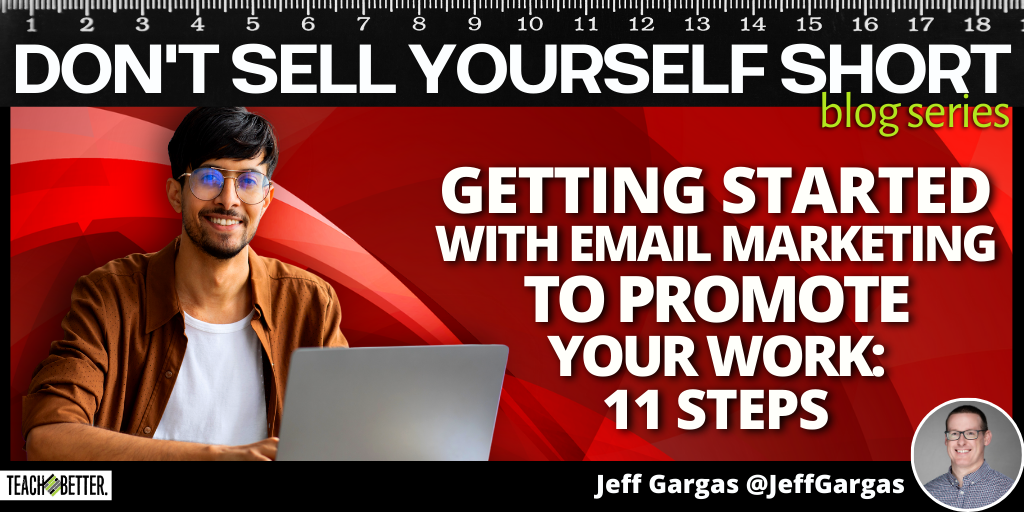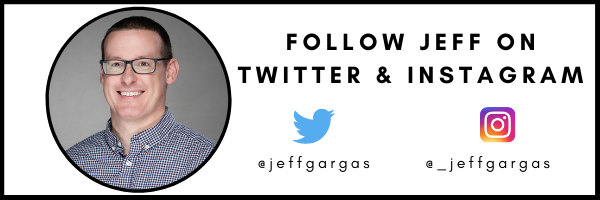TL;DR:
- Learn about the importance and value of email marketing as a powerful way to connect with your audience.
- 11 steps to consider as you start with email marketing to promote your work: (1) What is your purpose? (2) Who is your target audience? (3) Service provider (4) Lead magnet (5) Format (6) Set up welcome email (7) Set a consistent schedule (8) Build your list of recipients (9) Send first email (10) Measure results (11) Stay consistent!
Getting Started with Email Marketing to Promote Your Work
I have the pleasure, and honor really, to work with a lot of amazing educators who have the desire to create and share their creative work with others in the hopes that it will help them impact more students. One of the first, and most common, things I talk about is creating and sharing content through things like blogging, videos, podcasts, social media, etc.
Whether you’re promoting your new book, an online course, your Teachers Pay Teachers store, or hoping to get into educational speaking or consulting, putting out valuable and engaging content is key to building your brand. In fact, if you have that edupreneur itch, but you’re not sure what it looks like for you, the best thing you can start doing is just creating content. A lot of times, it’s that creative process that will lead you to where you’re supposed to be.
With creating content, your first goal should be to provide value. I will preach again and again that providing value should always be the primary goal as well. But the second goal is to have that content turn readers or listeners into customers or fans or supporters of the work you do and the goals you’re trying to accomplish.
People who know me know I am a firm believer in the power and importance of email marketing for any business or cause. I actually wrote a post years ago referring to email as the original social media. While it’s not technically a social media platform, it’s been around longer than any of the current platforms, has consistently performed better for businesses, and is showing no signs of going anywhere anytime soon.
In fact, the number of email users is projected to grow from 4.3 billion to 4.6 billion in the next two years (Oberlo, 2022) and the average ROI (Return On Investment) is $40 for every $1 you spend on email marketing (Omnisend, 2022). That is almost double the ROI of SEO ($22.24) and almost 2.5 times better than the return on running paid keyword ads.
More importantly, email marketing allows you to connect with your audience on your own terms. There is no algorithm to try and master, no fear that Gmail will bury your emails unless you pay for ads, and a much lesser chance that your audience could disappear at any time. Social media sites are vulnerable to changes in culture, lack of revenue, and poor decisions by their corporate leaders.
Email, on the other hand, has been shown to be a much safer place to stay connected to your audience, and people do not leave it behind as quickly as they might bounce from one social channel to the next. Reports show that 51% of people have kept the same email address for more than 10 years.
Along with all of that, email has continued to be our strongest and most consistent source for lead generation, audience engagement, and customer retention at Teach Better.
You have so much value to share, and I am so excited you are exploring ways to increase your impact. Start creating valuable content, build your email list, and keep being awesome. Click To TweetGetting Started with Email Marketing
At this point, I’m going to assume I have convinced you to at least consider email marketing as a strategy you want to use to promote your work. So let’s get into how you can get started with email marketing. Here are the first 11 steps I recommend.
Step 1: Think about the purpose of your email marketing.
Now, we could dive deep into setting goals, KPIs, etc., but all I need you to do right now is think about what you want your emails to do for your business or cause.
Some potential purposes are:
- Drive product/services purchases – your new book, online course, or TPT store, for example
- Build brand awareness – so maybe they think of you as a speaker for their next conference or event
- Inform people of your cause and the work you do – so they’ll want to get involved or support it via donations
- Nurture leads – help people get to know, like, and trust you and your brand so they’re more likely to work with you in the future
Step 2: Ensure everything is for your avatar.
Your avatar is your ideal client or audience member, sometimes referred to as your target audience, customer profile, ideal customer, etc. Essentially, who is it that you are trying to speak to? Who will find the most value from what you create? That is your avatar, and everything you do with email marketing should be with your avatar in mind.
Step 3: Pick your email marketing service provider.
- MailChimp
- Flodesk
- ActiveCampaign (what we use at Teach Better)
- ConvertKit
- GetResponse
- Substack
- Drip
- Campaign Monitor
- Constant Contact
- Sendinblue
Step 4: Create a lead magnet.
You need some way to get people to join your list. There are a million and one ways to do this, and you might hear them called “premium content piece,” “content offer,” “freebie,” “signup incentives,” “signup offers,” “content upgrades,” “opt-in bribes,” or many other terms. We’ll just use “lead magnet” as the broad term here. This is simply a piece of content that is valuable enough that people are willing to give you their name and email in exchange for access to it.
Some example lead magnets are:
- A downloadable PDF “cheat sheet” or “checklist” or “guide”
- An ebook – Which is just a book in PDF format
- Online course – They provide their email when they enroll
- Email challenge – A series of emails delivered over a set amount of time that guides them through a challenge to accomplish something
- Masterclass – They provide their email when they register
- Live or Pre-Recorded Webinar – They provide their email when they register
- Giveaway – Emails are collected when they enter to win
Step 5: Determine your email format.
Important note: This can always change as you learn more about your audience, what they want, what works, what doesn’t, etc. But you’ll want to pick a format to start with.
You could go with a more “newsletter” format, like Lindsay Titus does with her Define YOUniversity “2-2-2” newsletter. Or you could have a more text-based format like Teach Better uses. You can also play around with a few different ideas and see which people like most. There is no wrong answer here.
Step 6: Set up your welcome email.
Ideally, when someone joins your email list, they should enter an automation (sometimes called a journey) that welcomes them to your list and to your community. To prevent getting any of us overwhelmed, let’s focus on just ONE email to welcome them.
This email should do a few things:
- Welcome them to the list to ensure they meant to join
- Give them the option to opt out of the list in case they joined by accident
- Briefly introduce yourself (and/or your brand, cause, etc.)
- Tell them what to expect – How often you will email them, what you will send them, etc.
Step 7: Set your sending schedule.
The only wrong answer here is “inconsistently.” Whether you send once a month, twice a month, or 5 times a day, the correct answer is “consistently.” (I wouldn’t recommend 5 times a day.) I typically lean towards “more is better” but once a day is probably enough for most.
*NOTE: This can change as well. As you get to know your audience, you may adjust how often you send, what day(s) you send on, etc. To start, though, pick a consistent schedule that you can stick to.
Step 8: Start building your list.
There are a lot of ways you can begin to do this. You may already have a list of people who want emails from you, like from conferences. Or you might be launching your first lead magnet. Create your list with any contacts you have (that have given you permission to add them) and launch your lead magnet to begin building your list. You can add links or a pop-up CTA (call to action) on your website, share a sign up form on social media or when you speak at a conference, or collaborate with others and cross-promote your list on theirs (and vice versa). Just start building!
Step 9: Send your first email.
This one is key…you need to send an email! You don’t need to wait until you have 500 or 1,000 people on your list. Start with 50. Heck, start with 10. Just get it going!
Step 10: Measure your results.
Please note: It is important to measure your results, but even more important to not get too caught up in those numbers, especially at the beginning.
Numbers to look at:
- Open rate: This is the number of people who opened your email. A decent open rate is anywhere from 17-28%. If yours is below that, try some different formats for the subject line of your emails.
- Clickthrough rate (CTR): The number of people clicking a link in your email. A good click rate is 3-5%. If you’re not hitting at least 3%, look at the links you’re including. It’s better to use fewer links, and important to make sure the message of your email leads readers to the link. Like everything else, you’ll want to play around with the links you include and how you include them in order to find the right balance.
- Unsubscribes: The number of people unsubscribing from your email. Often, people focus too much on this one. Unsubscribes are not a bad thing, unless it’s consistently over 1%. Less than that, and you’re okay. Unsubscribes are normal and expected. Don’t sweat it!
Step 11: Stay consistent.
Keep sending those emails! This is not a 1-day, 1-week, or even 3-month thing. Even the best email strategies take time to produce results. Stay consistent, track your results, adjust and tweak things, and give it time to work.
You have so much value to share, and I am so excited you are exploring ways to increase your impact. Start creating valuable content, build your email list, and keep being awesome. If you ever need any help, just reach out!
So, what are you waiting for? Stop reading this post and go share your awesomeness!
About Jeff Gargas
Jeff is the COO/Co-founder of the Teach Better Team and co-author of “Teach Better.” He works with educators to increase student engagement and improve student success. Jeff previously owned an online marketing firm, where he worked with entrepreneurs and small businesses. He is also a former adjunctive professor at Kent State University and spent 10+ years in the music industry.




